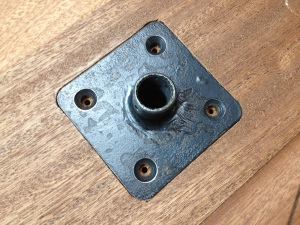My Best Hardware Layout Tool
 Do you have those tools in your shop that you have had so long and use so often that you forget they are even there? I got a question from a Hand Tool School member about something I used in a recent video. It was something I used to mark a hole for drilling. I immediately thought of my scratch awl but that wasn’t what he was referring to. I had to rewatch the video before I realized he was talking about my set of transfer punches (thank you to the social media sphere for that name as I had no idea what to call them) I have had these things so long that I have no idea where I got them or even what to call them. But it occurred to me just how dang useful they are and how often they come out of the cabinet when I’m installing hardware.
Do you have those tools in your shop that you have had so long and use so often that you forget they are even there? I got a question from a Hand Tool School member about something I used in a recent video. It was something I used to mark a hole for drilling. I immediately thought of my scratch awl but that wasn’t what he was referring to. I had to rewatch the video before I realized he was talking about my set of transfer punches (thank you to the social media sphere for that name as I had no idea what to call them) I have had these things so long that I have no idea where I got them or even what to call them. But it occurred to me just how dang useful they are and how often they come out of the cabinet when I’m installing hardware.
 I have starting installing hardware on my treadle lathe and the level of precision has stepped up several notches as I have machined parts interfacing with wood. For this I need highly accurate layouts. This flange plate is located mostly by the inlay it resides in, but if you drill one of the screw pilot holes slight off center the screw will ever so slightly torque the plate when you cinch it down and throw off the alignment and the axle won’t ride smoothly through the flywheel. Enter my transfer punches. My set has just about any size you need and you can reference it off the hardware to precisely locate the center of the hole. Give it a tap, then let your drill bit settle into the mark and go to work.
I have starting installing hardware on my treadle lathe and the level of precision has stepped up several notches as I have machined parts interfacing with wood. For this I need highly accurate layouts. This flange plate is located mostly by the inlay it resides in, but if you drill one of the screw pilot holes slight off center the screw will ever so slightly torque the plate when you cinch it down and throw off the alignment and the axle won’t ride smoothly through the flywheel. Enter my transfer punches. My set has just about any size you need and you can reference it off the hardware to precisely locate the center of the hole. Give it a tap, then let your drill bit settle into the mark and go to work.
If I remember right I actually bought these at an automotive store but the fact that I have seen a few of them pop up in woodworking catalogs lately tell me I’m not the only one using them for this purpose. When it comes to installing hardware whether it be a simple butt hinge or a more complex installation like a twin screw vise, you can’t beat one of these sets to make your life a whole lot more precise.
Your Turn
What little work aids do you have in your shop that get used so much you forget you have them? What other trades/hobbies do you borrow from to add that element of efficiency and/or precision to your woodworking? Please share in the comments below.


